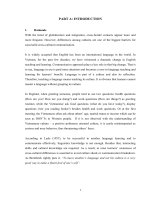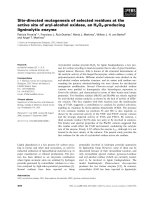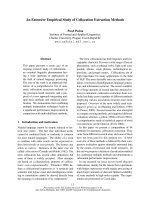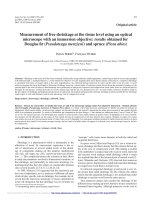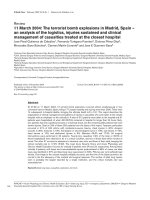An english-vietnamese cross-cultural study of keeping face at the first encounter
Bạn đang xem bản rút gọn của tài liệu. Xem và tải ngay bản đầy đủ của tài liệu tại đây (446.29 KB, 51 trang )
PART A: INTRODUCTION
1. Rationale
With the trend of globalization and integration, cross-border contacts appear more and more
frequent. However, differences among cultures are one of the biggest barriers for successful
cross-cultural communication.
It is widely accepted that English has been an international language in the world. In
Vietnam, for the past few decades, we have witnessed a dramatic change in English teaching
and learning. Communicative approach plays a key role in that big change. That is to say,
language in use is paid more attention and becomes a core in language teaching and learning
for learners’ benefit. Language is part of a culture and also its reflection. Therefore, teaching
a language means teaching its culture. It is obvious that learners cannot master a language
without grasping its culture.
In England, when greeting someone, people tend to use two questions: health questions
(How are you? How are you doing?) and work questions (How are things?) as greeting
routines while the Vietnamese ask food questions (what do you have today?), display
questions (Are you reading books?) besides health and work questions. Or at the first
meeting, the Vietnamese often ask about others’ age, marital status or income which can be
seen as DON’Ts to Western people. If it is not observed with the understanding of
Vietnamese culture – a positive politeness oriented culture, it is easily misinterpreted as
curious and nosy behavior, thus threatening others’ faces.
According to Lado (1957), to be successful in another language learning and to communicate
effectively, linguistics knowledge is not enough. Besides that, interacting skills and cultural
knowledge are required. As a result, to raise learners’ awareness of cross-cultural differences
is essential to avoid culture shock or communication breakdown. As Brembeck rightly puts
it, “To know another’s language and not his culture is a very good way to make a fluent fool
of one’s self”.
1
2. Aims of the study
The aims of study are:
- To find out safe and unsafe topics for the first encounter in Vietnamese and
Anglophone cultures.
- To examine politeness strategies employed by Vietnamese and Anglophone informants
under the influence of age, gender and power.
- To point out cross-cultural similarities and differences.
3. Methodology
Quantitative method is mainly exploited for the practical aspects of the cross-cultural
interaction under study. The following methods are used:
Survey questionnaire
Analysis of the collected data: statistic, descriptive, interpretive,
comparative and contrastive
Reference to home and foreign publication
Consultation with supervisor, Vietnamese and foreign colleagues.
4. Scope of the study
Non-verbal factors are believed to be very important for keeping face at the first encounter.
However they are beyond the scope of this study. The study only focuses on the verbal
aspects and the data analysis of politeness and safe and unsafe topics.
The study is limited within the first encounter conversation in five groups and 3 situations
The survey questionnaires are given to 100 native speakers of Vietnamese (NSVs) people
and 100 native speakers of English (NSEs) people. However, 50 questionnaires of the NSVs
and 50 questionnaires of NSEs are selected for.
5. Design of the study
The study consists of 3 parts:
- Part A: Introduction
- Part B: development
Chapter 1: Theoretical Preliminaries
Chapter 2: Methodology
Chapter 3: Results and discussion
- Part C: conclusion
2
PART B: DEVELOPMENT
CHAPTER I: THEORETICAL PRELIMINARIES
I.1. Culture and communication
I.1.1. What Culture?
Up to now, there have been many definitions of “culture”. It can be defined as “what makes
you a stranger when you are away from home. It includes all those beliefs and expectations
about how people should speak and act which have become a kind of second nature to you
as a result of social learning. When you are with members of a group who share your
culture, you do not have to think about it, for you are all viewing the world in pretty much
the same way and you all know, in general terms, what to expect of one another” (Bock,
1970:1).
According to Claire Kramsch, “culture can be defined as membership in a discourse
community that shares a common social space and history, and common imaginings. Even
when they have left that community, its members may retain, wherever they are, a common
system of standards for perceiving, believing, evaluating and acting.” (1998: 10).
Actually, people in one community acquire common ways of viewing the world, common
attitudes, beliefs and values… through their interactions. They “share the same background
(for example, national, ethnic, religious) resulting from a common language and
communication style, customs, beliefs, attitudes and values” (Quang, N, 1998: 3). However,
we can hardly see the influence of culture on each individual as “it refers to the informal and
often hidden patterns of human interactions, expressions, and viewpoints that people in one
culture share” (Quang, N, 1998: 3)
Adapted from Levine 1987:42)
3
I.1.2. What Communication?
Communication is “the process of sharing meaning through verbal and nonverbal
behavior” (Quang, N, 1998: 3).
Communication is also defined as “any process in which people share information, ideas,
and feeling. That process involves not only the spoken and written word, but also the body
language, personal mannerism and style, the surroundings – anything that adds meanings to
a message” (Hybels and Weaver, 1992: 5).
In a communication, meaning can be shared directly to hit the issues or indirectly to avoid
issues. It is called direct communication and indirect communication respectively. They all
concern the relation between the speakers’ communicative intention, the interlocutors’
expectation of the message and the communicative effects of the message.
Problems in communication, especially cross-cultural communication can fall into two
types:
Non-communication – where no message is communicated; and
Miscommunication - where an unintended message is communicated
(Clyne, 1994: 26)
It is the fact that for successful communication, the communicative effects should be
matched to the intention, therefore, there should be sensitiveness and understanding of
others’ production and the way they play with various identities which are available to them.
Hence, it is so important for a good communicator to realize the surrounding of others’
identities.
I.1.3. Culture shock in communication.
As discussed above, culture is “a complex whole which includes knowledge, belief, art,
morals, law, customs and any other capabilities and habits acquired by man as a member of
society” (Tylor, 1978: 59, cited in Holliday, Hyde and Kullman, 2004). Living in the same
society, we do not think about our culture for we all see it in the same way. Moreover, we
can also expect other’s behavior without surprising.
We cannot separate our life from cultures. Cultures impact on our daily activities in general
and on our communication styles in particular. This is all too obvious when we communicate
4
with others who do not share the same culture. Actually, communication styles can and do
create misunderstanding and shock in conversations among people from different cultural
backgrounds. This can be illustrated with one example below:
“The Italian made a strong political statement with which he knew his American friend
would disagree. The Italian wanted to involve the American in a lively discussion. The
American, rather than openly disagreeing, said, “Well, everyone is entitled to an opinion. I
accept that your opinion is different than mine.” The Italian responded, “That’s all you have
to say about it? In general, the American did not enjoy verbal conflicts over politics or
anything else. The Italian actually became angry when the American refused to get involved
in the discussion. He later explains to the American, “a conversation isn’t fun unless it
becomes heated” (cited in Quang, N, 1998: 40)
With this example, it is obvious that communication is much influenced by cultures. Before
we arrive in a new land, we can think much about the new things which will happen
differently there. However, no matter how much we are prepared for the new culture, we
find it hard to understand and accept the unfamiliar behaviors and sometimes hard to
overcome the new situations. The result is we still feel shocked.
“Culture shock is neither good nor bad, necessary nor unnecessary. It is a reality
that many people face when in strange and unexpected situations” (Harris and Moran, 1998:
226). Culture shock is related to the feelings in the hearers (Hs) or speakers (Ss) of
“estrangement, anger, hostility indecision, frustration, unhappiness, sadness, loneliness,
homesickness and even physical illness” (Valdes, 1995: 35).
I.1.4. Communicative Competence (C.C)
CC is understood as the knowledge that interlocutors need in communication. It is not only
the grammatical forms but also the knowledge which is the ability for both Ss and Hs to use
in the appropriate way in any contexts. It is a whole of knowledge and many other elements
concerned in communication in general and in the intercultural communication in particular.
Saville – Troike (1985: 215) assumes:
Communicative competence extends to both knowledge and expectation of who may
or may not speak in certain settings, when to speak and when to remain silent, whom one
may speak to, how one may talk to persons of different statuses and roles, what appropriate
nonverbal behaviors are in various contexts, what the routines for turn – taking are in the
5
conversation, how to ask for and give information, how to give commands, how to enforce
discipline, and the like – in short, everything involving the use of language and the other
communicative dimensions in particular social settings.
Along the line, Richards et al. (1992: 65) gives out his definition of CC which consists of:
a, knowledge of the grammar and vocabulary of the language.
b, knowledge of rules of speaking (e.g. knowledge how to begin and end a conversation,
knowing what topics may be talked about in different types of speech events, knowing which
address forms should be used with different persons one speaks to and in different situation).
c, knowing how to use and respond to different types of speech acts such as requests, advice,
apologies, thanks and invitations.
d, knowing how to use language appropriately.
Upon this view, it is vitally important to build up the socio-cultural rules for language use as
an integral part for a successful communication.
I.1.5. Small talk in communication
Sue: It’s nice to meet you. My friend told me about you. Have you lived in Seattle long?
Mark: No, only three months. How about you?
Sue: I moved here three years ago from California.
Mark: Oh really? I am from California too! Where did you live in California?
Sue: In Gilroy, not far from San Jose.
Mark: This is really coincidence. I am from Gilroy too. I like telling people I am from the
garlic capital of the world. Did you usually go to the summer garlic festival?
Sue: I used to go every summer. How about you?
Mark: I went to most of them. I thought the one in 1980 was great. Did you go to that one?
(Levine and Adelman, cited in Quang, N, 1998: 47).
In this conversation, the two participants are asking small talk questions before they found
that they share some common backgrounds. It can be seen that the conversation is working
easily with small talk questions and this kind of conversation above is called “small talk”. A
small talk is defined as an everyday conversation about everyday matters, usually at social
events. Normally, small talk is not considered important but it is “an essential aspect of
conversation in that it provides a means of easing things along” (Clyne and Michael, 1994:
84). It is used to initiate a conversation after the introduction and functions for maintaining
6
conversations such as keeping them going on, leading to interesting debates. However, small
talk requires common expectations among participants about its appropriateness and a
common willingness and cultural understanding to take part in.
I.2. Politeness
I.2.1. What Face?
The nature of politeness has been debating for a very long time by the linguists and still not
agreed on exactly what it is. Face is the central notion discussed in the area of politeness.
Language users are social beings whose various social beliefs, motives and goals are brought
into their verbal interaction. The nature of their conversation is affected by these variables;
over time they play a role in development of language. It is certain that social motives and
goals impact the use of language. When we are in a particular contact, especially at the first
encounter where we do not know much or even anything about the others, we need to make
our partners see our pleasure to communicate to them. Here face - a social psychological
concept and face-work entailed are needed to maintain the communication. According to
Goffman (1967), face, or one’s public identity, is a “scared thing”; so people are strongly
motivated to protect and manage their face. Face is something which is not located in our of
our body but “rather something that is diffusely located in the flow of events in the
encounter” (Goffman, 1967: 7)
According to Brown and Levinson (1987, 61), face can be defined as “the public self-image
that every member wants to claim for himself”. It is the emotional and social sense of self
that everybody has and expects others to recognize. Face consists of two related aspects:
negative and positive face.
Negative face is the basic claim to territories personal preserves, right to non-
distraction, i.e.: to freedom of action and freedom from imposition.
And positive face is the positive consistent self-image or “personality” (crucially
including the desire that this self-image be appreciated and approved of) claimed by
interactants.
In other words, negative face is a person’s want to be unimpeded by others and the
desire to be free to act as s/he chooses and not be imposed on: a desire for autonomy and
7
positive face represents a desire for approval, a person’s want to be highly appreciated and
approved by selected others in terms of personality, desires, behavior, values and so on.
Yule (1996: 60) supports the idea that face is “the public self – image of a person”. The
emotional and social sense exists in ourselves and also is something which is expected to be
recognized by others. According to him, “politeness is the means employed to show
awareness of another’s face”. If someone says something which threatens others’ self-
image, it is called a “face threatening act” (FTA). And alternatively, when something is said
in order to lessen the threat to others’ individual expectations, it is named a “face saving act”
(FSA). In any social communication, people are strongly motivated to protect and manage
their positive image which reflects the values and beliefs of themselves. Moreover, because
face can only be given by others, it is in everyone’s best interest to maintain each other’s
face. When this fails, their feeling may be hurt and “loss of face” is a consequence in the
communication.
In the social meetings of the human beings, the participants do their best to communicate
with their positive face which reflects their values and beliefs. Face-work is involved in the
social communication and is the efforts by the participants to avoid losing others’ face. Face-
work entails both avoidance strategies (e.g., avoiding unsafe topics or violating another’s
territory) and approach-based strategies (e.g., greeting, compliments, and salutations to
support one’s relationship).
I.2.2. What Politeness?
Politeness can be viewed as essentially the linguistic means by which face-work is
accomplished. Although politeness is driven by face concerns, these concerns can over the
time, settings, individuals, cultures and so on. It lies at the intersection of cultural, social,
cognitive, and linguistic processes.
Politeness carries a significant role in human interaction in the society. Politeness theory can
be seen as a sub-discipline of pragmatics, it can be viewed as an aspect of speech which is
governed by the rational rules. They are nothing but the human’s need to maintain the social
relationship, peace and to avoid or lessen the conflicts.
8
Hence, politeness, as Brown and Levinson (1987: 13) defines, “is basic to the production of
social order and a pre-condition of human cooperation”.
According to Richards et al (1985:281), politeness is also considered as a matter related to
face which is used to maintain the social interaction:
(a) How languages express the social distance between speakers and their different role
relationships.
(b) How face-work, that is, the attempt to establish, maintain and save face during
conversation, is carried out in a speech community. Languages differ in how they
express politeness.
According to Yule (1997: 60), Politeness is viewed as “the idea of “polite social behavior”,
or etiquette within a culture”. In other words, politeness is “a number of different general
principles for being polite in social interaction within a particular culture”.
I.2.3. Politeness Strategies
Politeness up to now has been addressed in different ways by linguists, e.g., Blum-Kulka et
al (1985), Blum-Kulka (1987,1990), Janney and Arndt (1992), Mao (1994), Kasper (1990),
Fraser (1990), Lakoff (1990), Leech (1983), Brown and Levinson (1987)… However, some
general principles are agreed for politeness in the human socio-communicative verbal
interaction. They are Politeness Rules by Lakoff (1990), Politeness Strategies by Brown and
Levinson (1987) and Politeness Principles – Maxims by Leech (1983). Of all, Brown and
Levinson’s theory is the most outstanding and most quoted.
In the Politeness theory by Brown and Levinson (1987), politeness is considered as a
complex system for softening face-threatening acts. The concept of face is a fundamental
construct in this theory. More importantly, it can be seen as a meditating variable, a construct
which is used to meditate between language use and a host of social psychological variables.
As a result, five strategies of politeness so as to minimize the loss of face are set up by
Brown and Levinson (figure No 1). In social communication, the choice of strategy which is
made depends on the interlocutors’ background, education, culture etc. According to Brown
and Levinson (1987), negative politeness seems to be more polite. Hence, it is put at a higher
degree of politeness than positive one. However, this appears controversial cross-culturally.
9
In the Western cultures, negative politeness is preferable in communication for its
conventionalization but it seems opposite to the Asian cultures, particularly to the
Vietnamese one. Positive politeness tends to be their preferred choice for saving face for
narrowing the gap among the interactants as well as making their relationship closer in the
talk. Although Brown and Levinson’s chart is highly appreciated, Quang, N. (1998) offers
another figure (figure No2) with some comments on its universal values. According to him,
negative politeness is as powerful as positive politeness is on equal footing in
communication.
10
I.2.3.1. Positive Politeness Strategies
11
According to Brown and Levinson (1987: 101), “positive politeness is redress directed to
the addressee’s face, his perennial desire that his wants (or the action, acquisitions, values
resulting from them) should be thought of as desirable. In positive politeness the sphere of
redress is widened to the appreciation of other’s wants in general or to the expression of
similarity between ego’s and other’s wants”.
Quang, N, (2003: 24) holds that “positive politeness is any communicative act which is
intentionally and appropriately meant to show the speaker’s concern to the addressee, thus,
enhancing the sense of solidarity between them”. Quang, N sees that while communicating,
Vietnamese people tend to show their attention to the others’ problems and give their hands
when necessary. As a result, seventeen strategies of positive politeness are suggested, of
which fifteen first ones are originally adopted by Brown and Levinson.
• Strategy 1: Notice, attend to H (his interest, wants, needs, goods)
Eg: You must be so hungry. How about dinner now?
Chà, hôm nay có phi vụ gì mà cậu diện bộ củ này thế?
• Strategy 2: Exaggerate (interest, approval, sympathy with H)
Eg: What a fantastic novel you have!
Nhờ tập thể thao thường xuyên, chị có phom người tuyệt vời quá!
• Strategy 3: Intensify interest to H
Eg: You know, pink you like, so good color.
Xinh như cậu thì có hàng tỉ anh chết.
• Strategy 4: Use in-group identity markers
Eg: Let’s go for a walk, honey.
Chị em mình đi ăn kem đi.
• Strategy 5: Seek agreement
Eg: A: I am learning French now for my further study.
B: French! Great.
A: Anh chuẩn bị chuyển công ty rồi. Anh sẽ chuyển về làm ở ngân hàng
Vietcombank.
B: Ngân hàng Vietcombank hả? Xin chúc mừng anh.
• Strategy 6: Avoid disagreement
Eg. She is beautiful, however, a bit small.
12
Tôi hiểu những khó khăn mà anh gặp phải, nhưng mỗi cơ quan đều có một
nguyên tắc riêng.
• Strategy 7. Presuppose/raise/assert common ground
Eg. Oh, dear, I have lost something, have we, Vuong?
Chị biết đấy, chồng em chịu khó lắm nhưng bận nên cũng không giúp em được
gì.
• Strategy 8. Joke
Eg. Is it ok if I tackle this good apple?
Chị đâu dám cưa sừng làm nghé hả em?
• Strategy 9. Assert or presuppose S’s knowledge of and concern for H’s wants
Eg. I know that roses are your favorite in your party but there are nothing left in the
market, hence lilies are instead today.
Theo như tôi được biết, anh đã xoay xở công việc trên Hà Nội một mình mà vẫn
thành công.
• Strategy 10. Offer promise
Eg. I will give you one hand for your birthday next week.
Lúc nào rảnh anh sang thăm nhà em nhé?
• Strategy 11. Be optimistic
Eg. Maybe, I have to go now.
Cậu khéo tay hay làm thì làm món sa lát Nga cho mình nhé.
• Strategy 12. Include both S and H in the activity.
Eg. Let’s go out for dinner now.
Ta nghỉ ăn trưa đã.
• Strategy 13. Give (or ask for ) reasons.
Eg. Why don’t you spare some time for yourself?
Tại sao anh không đi câu cá cùng chúng tôi vào cuối tuần này nhỉ?
• Strategy 14. Assume or assert reciprocity
Eg. You cook and I tidy up the house, ok?
Có gì đâu. Chẳng lẽ anh chị đã quên là anh chị đã giúp em rất nhiều à?
• Strategy 15. Give gift to H (goods, sympathy, understanding, cooperation)
Eg. I have a present for you. It’s a scarf from India.
Tớ vừa đi Ấn Độ về. Tớ mua tặng cậu chiếc khăn tơ tằm này.
• Strategy 16. Encourage
13
Eg. Never mind! Better luck next time.
Đừng sợ. Anh sẽ luôn đứng sau ủng hộ em.
• Strategy 17. Ask personal question
Eg. How old are you?
Lương của cháu trên trường Xây Dựng có cao không?
I.2.3.2. Negative Politeness Strategies
In Brown and Levinson (1987: 129), negative politeness is “redressive action addressed to
the addressee’s negative face: his want to have his freedom of action unhindred and his
attention unimpeded”. Quang, N, (2003: 88) shares this opinion “negative politeness is any
communicative act which is intentionally and appropriately meant to show that the speaker
does not want to impinge on the addressee’s privacy, thus maintaining the sense of distance
between them”. In order to avoid FTAs, eleven negative strategies are given out.
• Strategy 1. Be conventionally indirect
Eg. Honey, it is time for tea.
Anh có thể cho tôi mượn xe máy của anh một lát được không?
• Strategy 2. Question, hedge
Eg. I think she’s not learning more.
Dạ, phiền anh có thể cho tôi mượn xe một phút được không ạ?
• Strategy 3. Be pessimistic
Eg. Could you jump over that five-foot fence?
Có lẽ anh mua giùm cho chiếc điện thoại đó nhé.
• Strategy 4. Minimize the imposition
Eg. I just want to borrow you a little pen.
Con chỉ nếm một chút thôi ạ.
• Strategy 5. Give deference
Eg. Ass. Prof Nguyen, I am looking forward to hearing from you.
Dạ, kính thưa cụ, cụ có thể thưởng thức trà được chưa ạ?
• Strategy 6. Apologize
Eg. I am so sorry to trouble you.
Xin lỗi, chị có thể chỉ cho tôi đường đến hồ Hoàn Kiếm được không ạ?
• Strategy 7. Impersonalize S and H
14
Eg. Open the door!
Tôi đề nghị ngày mai chúng ta đi làm đúng giờ nhé.
• Strategy 8. State the FTA as a general rule
Eg. Passengers will please refrain from flushing toilets on the train.
Ta không nên bàn chuyện làm ăn ở chốn đông người.
• Strategy 9. Nominalize
Eg. I am pleased to be able to inform you that you have passed the exam.
Ngày càng nhiều công ty nước ngoài vào Việt Nam đầu tư cho ngành viễn thông.
• Strategy 10. Go on record as incurring a debt, or as not indebting H
Eg. I could easily do it for you any time.
Bác làm ơn làm phúc giúp cháu nốt lần này nhé.
• Strategy 11. Avoid asking personal questions.
Eg. The weather today is so hot, isn’t it?
Giao thông Hà Nội gần đây tệ hại quá.
An empirical study of keeping face at the first encounter in English and Vietnamese within
the boundary of safe and unsafe topics and small-talk starters in the light of politeness theory
is to be conducted.
CHAPTER II: METHODOLOGY
15
II.1. Research questions
For the achievements of the aims of study in chapter one, three research questions are
addressed:
1. What topics do NSEs and NSVs often resort to for avoidance of face threat
at the first encounter?
2. Do NSEs differ from NSVs in terms of their evaluation of power, age and
gender realizing small-talk starters at the first meeting in the contexts
studied?
3. If yes, how do their evaluations affect their choice of politeness strategies?
II.2. Data collection methods
II.2.1.The discourse completion task (DCT).
There have been so far some good methods for cross-cultural and inter-language studies such
as ethnographic method, role – play method and discourse completion task (DCT). In terms
of ethnographic method, the most advantageous point is that the authentic or natural data are
collected through daily conversations. However, we can hardly manage the contextual
variables that can happen in the same contexts. Moreover, it takes much time to transcript the
tapes recorded. As for role-play method, it also has one advantageous point. That is to record
the conversations which are arranged with subjects asked to make face-to-face
conversations. One thing different to the above method is that in this method, the contextual
variables are controlled. But to do this method, it also takes much time on tape records. DCT
appears to be the method which can solve the limitation of the two methods above. DCT
consists of two different types: Oral Completion Task and Written Completion Task. The
first one is modeled as a closed role-play and in this closed role-play; the researcher will
verbally describe the situations and ask the role-playing people what to say in the situations.
The second one consists of written interactions. Briefly described situations are given and
the researchers will ask the informants to write down what they will say in those situations.
Although this method has the limited point which is non-authentic collected data or the
absence of prosodic and non-verbal features, the research author still chooses this one for the
following reasons: Firstly, this method can control the internal context variables such as
social distance and power which, according to Brown and Levinson (1987), strongly affect
the linguistic forms in interaction, and also the external context variables such as age,
16
occupation, sex….Second, DCT works as an effective tool of collecting a big amount of data
quickly and easily. These seem to be suitable for the author’s study with time constraint.
II.2.2. Data collection instrument
Two questionnaires are designed for the aim of data collection. The first one is a multiple-
choice questionnaire (MCQ) which is plotted separately for the author’s aim to get results to
design the DCT, also the other part of the survey questionnaire. The MCQ consists of 20
suggested topics. The informants are asked to put a tick (v) in the place where they think it is
advisable to mention the topics at the first meeting so as to be safe. There are five different
degrees: highly advisable, advisable, all right, unadvisable and strongly unadvisable.
Because there are two groups of informants: NESs and NVSs, hence, the survey
questionnaire is designed into two versions. The English version is for the English
informants. And the Vietnamese one is for Vietnamese informants. The topics with the high
rates of “highly advisable”, “advisable” and “all right” for both English and Vietnamese are
work, studying, weather, sports, family, music, place of birth and place of residence.
Nevertheless, due to limited time, three topics of work, family and sports are selected to
design the DCT. A sample item of MCQ and DTC is given below:
I. Do you think it is advisable to mention the following topics at the first meeting
so as to be safe?
17
Please tick (v) in one of the following columns:
Column 1 means: highly advisable (HAD)
Column 2 means: advisable (AD)
Column 3 means: all right (AR)
Column 4 means: unadvisable (UAD)
Column 5 means: strongly unadvisable (SUAD)
Ord Topics 1 2 3 4 5
1 Age
2 Politics
3 Weight
4 Salary
5 Work
6 Weather
7 Material life
8 Religion
9 Sex life
10 News
11 Studying
12 Music
13 Health
14 Pets
15 Family
16 The cost of particular
items
17 Other people’s affairs
18 Sports
19 Marital status
20 Place of current
residence
DCT
II. When you first meet your business partner in the office, how would you talk to
him/her about your and/or his/her work? (He/She is your age and your gender)
a. He/She is of higher status:
……………………………………………………………………………………
b. He/She is of equal status:
……………………………………………………………………………………
c. He/She is of lower status:
……………………………………………………………………………………
18
III. When you first meet your new neighbor in the street, how would you talk to
him/her about your and/or his/her family? (He/She is your gender and your
power-equal)
a. He/She is 10 years older than you:
……………………………………………………………………………………
b. He/she is at your age
……………………………………………………………………………………
c. He/She is 10 years younger than you:
……………………………………………………………………………………
IV: When you first meet your new friend at a party, how would you talk to him/her
about sports? (He/She is your age and your power-equal)
a. That person is male
……………………………………………………………………………………
b. That person is female
……………………………………………………………………………………
The instructions in both MCQ and DCT are clearly provided so that the informants can
easily understand and give their best answers. The author hopes that the tokens collected
from the survey questionnaire are authentic, natural, typical and reliable for consideration
and evaluation. However, as limitations of the study, some aspects are not covered:
- Paralinguistic factors: pitch, intensity, rate, other vocal qualities, etc.
- Non-verbal factors: facial expressions, gestures, eye contact, etc.
- Setting of communication: place, distance, lighting system, heat, etc.
- Mood factors: happy, unhappy, bore, excited, etc.
II.3. Subjects of the study:
The survey is conducted with two groups: one is NSEs and the other is NSVs. The
Vietnamese informants are working in Hanoi, Vietnam, and the English informants who
work for British Council, Language Link, Hilton Hotel or come to Vietnam as tourists.
Questionnaires were delivered to 100 NSEs and 100 NSVs. However, 50 questionnaires of
NSEs and 50 questionnaires of NSVs are selected for.
19
Among 50 questionnaires of NSEs, 23 are from NSEs who are working in British Council,
18 are from Language-Link Center, 5 from Hilton Hotel, and the rest are from tourists in
Vietnam. About 50 questionnaires of NSVs, 15 are from NSVs who are working in
University of Civil Engineering, 10 are from the author’s neighbors, 5 are from third-year
students and the rest are from the author’s friends who are working in different companies,
factories.
Besides, as it is believed that the informants’ profiles are important for the research, they are
requested to provide information about:
• Their nationality
• Their age
• Their sex
• Their marital status
• Their occupation
• Their residence
• Their acquisition of foreign language
The informants are assured not to be identified in any discussion of the data for the
authenticity of the survey questionnaire.
CHAPTER III: RESULTS AND DISCUSSION
III.1. Safe and unsafe topics at the first encounter
Normally, when starting a conversation at the first meeting, after introducing and being
introduced, people have to think of what to say to keep it going. Topics at the first encounter
are so important for good impression and hence, leading to a further relationship. As we
come from different cultures with different characteristics, and cultural hiddens vary from
society to society, what are said can satisfy someone in one culture but hurt others in another
20
culture, especially at the first encounter. That is why topics to talk about in the small talk of
the first meeting appear important.
III.1.1. Data analysis.
Collected data from question number 1 are used as the linguistic input. 20 topics are
mentioned in this part. Fifty Vietnamese and fifty English are requested to tick (v) in one of
five columns for each topic they think advisable or unadvisable at the first meeting. The aim
of this part is to focus on whether they think they should mention the suggested topics or not
for a smooth - flowing conversation.
III.1.1.1 English findings
Column 1 means: highly advisable (HAD)
Column 2 means: advisable (AD)
Column 3 means: all right (AR)
Column 4 means: unadvisable (UAD)
Column 5 means: strongly unadvisable (SUAD)
Ord Topics 1 2 3 4 5
1 Age 9% 78% 13%
21
2 Politics 85% 15%
3 Weight 89% 11%
4 Salary 94% 6%
5 Work 93% 7%
6 Weather 96% 4%
7 Material life 8% 92%
8 Religion 88% 12%
9 Sex life 100%
10 News 73% 27%
11 Studying 91% 9%
12 Music 10% 88% 2%
13 Health 90% 6% 4%
14 Pets 87% 13%
15 Family 92% 8%
16 The cost of particular items 90% 10%
17 Other people’s affairs 94% 6%
18 Sports 5% 91% 4%
19 Marital status 6% 80% 14%
20 Place of current residence 20% 65% 15%
Table 1: Percentages of suggested topics in the first encounter of English informants
As we can see from the table 1, NSEs are so open to talk about such topics as weather (96%
AD), work (93% AD), news (73% AD), studying (91% AD), music (88% AD), health (90%
AD), pets (87% AD), family (92% AD), sports (91% AD) and place of current residence
(65% AR) meanwhile some topics seem to be avoided to be discussed such as age (78%
UAD), politics (85% UAD), weight (89% UAD), salary (94% UAD), material life (92%
UAD), religion (88% UAD), sex (100%SUAD), the cost of particular items (90% UAD),
other people’s affairs (94% UAD) and marital status (80% UAD). These topics carry the
personal and private information for an initial meeting.
III.1.1.2. Vietnamese findings
Column 1 means: highly advisable (HAD)
Column 2 means: advisable (AD)
Column 3 means: all right (AR)
Column 4 means: unadvisable (UAD)
Column 5 means: strongly unadvisable (SUAD)
Ord Topics 1 2 3 4 5
1 Age 22% 72% 6%
22
2 Politics 6% 84% 10%
3 Weight 35% 65%
4 Salary 15% 70% 15%
5 Work 75% 22% 3%
6 Weather 40% 60%
7 Material life 8% 90% 2%
8 Religion 8% 80% 12%
9 Sex life 100%
10 News 60% 40%
11 Studying 27% 68% 5%
12 Music 20% 75% 5%
13 Health 30% 70%
14 Pets 16% 84%
15 Family 80% 20%
16 The cost of
particular items
19% 81%
17 Other people’s
affairs
11% 7% 82%
18 Sports 80% 20%
19 Marital status 32% 60% 8%
20 Place of current
residence
27% 70% 3%
Table 2: Percentages of suggested topics in the first encounter of Vietnamese informants
It can be seen from the table that, in the first meeting, NSVs tend to talk about topics such as
age (72% AD), work (75% AR), weather (60% AR), news (60% AD), studying (68% AR),
music (75% AD), health (70% AR), pets (84% AR), family (80% AD), cost of particular
items (81% AR), sports (80% AD), marital status (60% AR), place of current residence (70%
AR). However, some topics are avoided such as politics (84% UAD), weight (65% UAD),
salary (70% UAD), material life (90% UAD), religion (80% UAD), sex life (100% SUAD)
and other people’s affairs (82% SUAD) for their sensitiveness to the first meeting.
III.1.2 Cross-cultural similarities and differences
From the results shown in table 1 and 2, it is observed that some of these twenty suggested
topics are preferred in the first meeting by NSVs while avoided by NSEs. Those are age,
marital status, the cost of particular items. It might be the case that the Vietnamese regard
such private and personal topics as good opportunities for them to show their concern,
friendliness, consideration to their communicating partners even in their first meeting. This
seems to prove the positive-politeness orientation of the Vietnamese culture.
23
According to the survey, both English and Vietnamese informants are willing to talk about
weather, music, health, pets, work, studying, news, sports, family and place of residence in
the first meeting. They also share one common thing: avoiding sensitive topics such as
salary, politics, sex life, material life and religion. This can be shown in the following table:
Ord Topics English Vietnamese
1 Weather 96% 60%
2 News 73% 60%
3 Music 88% 75%
4 Work 93% 75%
5 Pets 87% 84%
6 Studying 91% 68%
7 Sports 91% 80%
8 Family 92% 80%
9 Health 90% 70%
10 Place of residence 65% 70%
Table 3: Percentages of topics both English and Vietnamese informants like to mention in small talks in the
first encounter.
The table shows that these topics are more preferred by NSEs than NSVs. Weather is the
most different topic in percentage (NSEs 96% “AD” and NSVs 60% “AR”), followed by
Work (NSEs 93% “AD” and NSVs 75% “AR”), Studying (NSEs 91% “AD” and NSVs 68%
“AR”) and Health (NSEs 90% “AD” and NSVs 70% “AR”). Then comes the topics Sports
and Family which have quite similar level of difference. The topics which have smallest
difference are Pets and Place of residence, accounting for 87% “AD”, 65% “AR” and 84%
“AR”, 70% “AR” for NSEs and NSVs respectively, and then comes News and Music.
For the public image of interlocutors in the first meeting, both NSEs and NSVs have some
sensitive and affecting topics to avoid. This can be shown in the below table.
Ord Topics English Vietnamese
1 Salary 94% 70%
2 Material life 92% 90%
3 Politics 85% 84%
4 Sex life 100% 100%
5 Religion 88% 80%
6 Other people’s affairs 94% 82%
Table 4: Percentages of topics both English and Vietnamese informants do not like to mention in small talks
in the first encounter.
24
The table does not show much difference in the percentage of avoided topics. It is obvious
that “Sex life” topic is the most sensitive one and both NSEs and NSVs do not talk about it,
accounting for 100% “SUAD” for both. Then comes the topics of Material life (92% “UAD”
for NSEs and 90% “UAD” for NSVs), Politics (85% “UAD” for NSEs and 84% “UAD” for
NSVs), followed by Religion, Other people’s affairs and the biggest difference is Salary
which accounts for 94% (UAD) for NSEs and 70% (UAD) for NSVs.
To summarize, at the first encounter, the topics which are considered safe for both the
English and Vietnamese informants are Weather, News, Music, Work, Pets, Studying, Sports,
Family, Health and Place of residence. The topics regarded as unsafe are Salary, Material
life, Politics, Sex life, Religion and Other people’s affairs.
III.2. Politeness Strategies used at the first encounter.
In this part, the results of the investigation of Politeness Strategy (PS) are presented. NSEs
and NSVs’ use of Positive Politeness Strategies (PPSs), Negative Politeness Strategies
(NPSs), Mixed Positive Politeness Strategies (MPPSs), Mixed Negative Politeness Strategies
(MNPSs) and Mixed Positive - Negative Politeness Strategies (MPNPSs) through three
situations is reported.
In this study, both English informants and Vietnamese informants are asked to talk or ask
their business partner in the office about informants’/his/her work, their new neighbor about
informants’/his/her family in the street, someone whom the participants have just made
acquaintance with about sports in a party. The speech act of asking or talking like this
conveys Politeness. Hence, to study the ways they use, the research author uses the Theory
of Politeness by Brown and Levinson and Quang, N. There are 3 categories: Positive
Politeness Strategies (PPSs), Negative Politeness Strategies (NPSs) and Mixed Politeness
Strategies (MPSs) are used as analytical framework. In each category, the strategies are
exploited by the participants, and then calculated as percentages. The frequency of using the
strategies in each category is symbolized F.
III.2.1. English findings.
III.2.1.1. Power influence in the communication at the first encounter.
25
